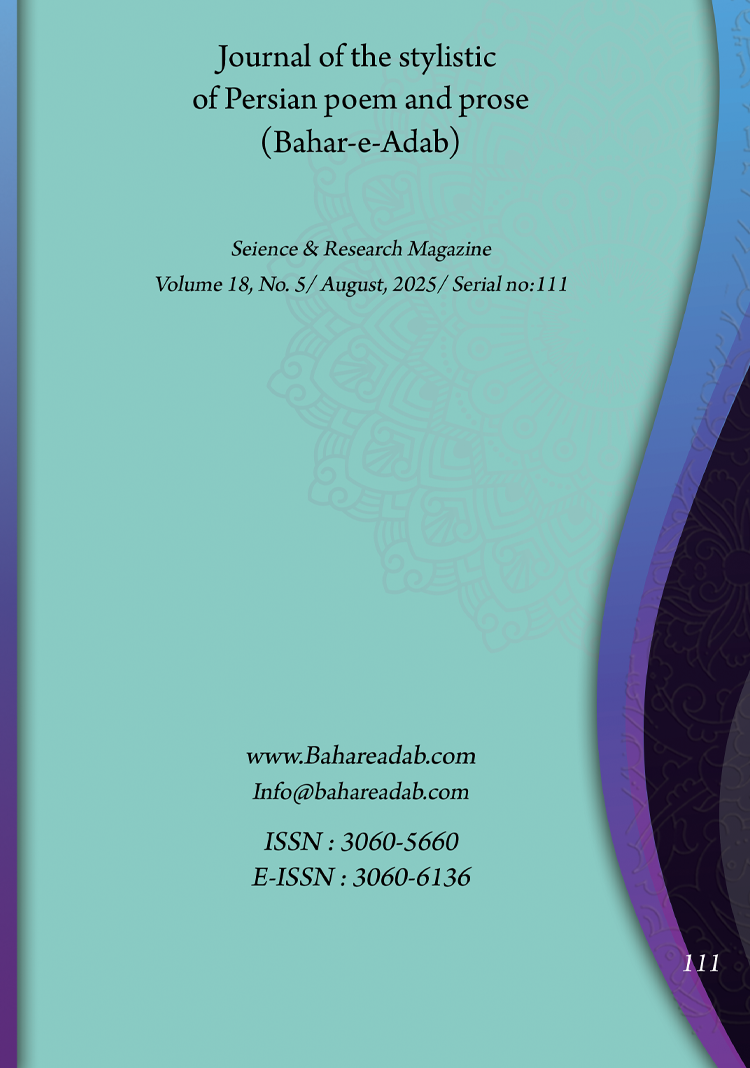- Count View : 27
- آدرس کوتاه شده مقاله: https://bahareadab.com/article_id/1862
- کد doi مقاله: Doi: 10.22034/bahareadab.2025 .18 .7877
Journal of the stylistic of Persian poem and prose
volume Number 18،
number In Volume 5،
،
issue Number 111
A Comparative Study of Two Manuscripts of the Epic Poem "Fathnameh-ye Hassam-Al-Mulk" by Mirza Ahmad al-Hami Kermanshahi (1264-1325 AH)
Ahmad Ghaderi , Mehri Pakzad (Author in Charge), Shahbaz Mohseni
Abstract
BACKGROUND AND OBJECTIVES: The poem Fathnama of Hosam-ul-Mulk written by Mirza Ahmad Elhami of Kermanshahi (1264-1325 AH) is one of the written heritages of Iranian culture and literature, which has remained unknown until now and has not been properly corrected. The content of this poem is consistent with the daily report book of Hossam al-Mulk, the ruler of Kermanshah during the period of Naser al-Din Shah Qajar before the constitution. The Fatehnameh is introduced based on two authentic versions preserved in the manuscript archive of the Islamic Council under the number 2535 and the Senate Library under the number 1170 To identify and investigate a rare treasure from the dusty treasures of Persian language and culture.
METHODOLOGY: Library method and descriptive-analytical method were used in writing this article. The version used in this research has been corrected based on the basic and eclectic version using scholarly insight and reasoned opinions of ijtihad with accuracy and caution and respecting the condition of trust based on the two versions available in the Manuscript Center of the Islamic Parliament Library.
FINDINGS: Examining Kermanshahi"s poem Fathnameh Ilhami, it can be said that she is one of the poets of the return period and inclined to the Khorasani style, and in this epic poem, she is a follower and imitator of Ferdowsi"s style. This 2,500 verse poem in the form of a Masnavi is a description of the events of the suppression of the "Hamavands" or "Ahmadvand Chalabi" by Hossam al-Molk. In creative arts - verbal and spiritual - moderate and at the intellectual level, religious love is the main axis in the beginning towards the Ahl al-Bayt and imams, as well as praising the rulers and the sultan of the time and aligning with the ruling goals.
CONCLUSION: The importance of this poem, apart from the literary aspect and the poet"s following of the Shahnameh style, is important as a historical source of the Qajar period. And on the other hand, since it recounts one of the regional and local events, it can be considered an important reference in the compilation of the local history of one of the great provinces of Kermanshah.
Keyword
Manuscript
, Ahmad Elhami Kermanshahi
, Fatehnameh
, stylistic analysis
, style of the return period.
- Arinpour, Yahya. (1995). From Nima to Our Time. Tehran: Zavar Publications.
- Afshar, Iraj & Mohammad Taqi Daneshpajouh et al. (1992). Catalog of Manuscripts in the National Malek Library (Volume 3 of Persian Books). Tehran: Astan Quds Razavi Publications. pp. 2-15.
- Al-Hami Kermanshahi, Ahmad. (2015). Shahnameh (Chaharkhiyaban Bagh-e Ferdows). Edited by Ali Ensani. Tehran: Islamic Propagation Organization. pp. 14.
- Al-Hami, Ahmad. (2005). Fathnameh-ye Hassam al-Mulk, Including the Poem of Mohariyat-e Javanmir and Malek Niyaz Khan. Tehran: Saham Publications. pp. 112-130.
- Binesh, Taghi. (2007). "The Method of Editing Persian Texts." In Collection of Editing Method Articles, edited by Mohammad Nazari. Tehran: Central Library and Documentation Center, University of Tehran. pp. 114.
- Jahanbakhsh, Juya. (2005). Guidelines for Editing Texts. Tehran: Miras-e Maktoob Publications. pp. 29-33.
- Khosravi, Mohammad Baqer. (1925). Divan-e Khosravi. Introduction by Rashid Yasami. Tehran: Broukhim Printing House. pp. 1.
- Sajjadi, Alaa al-Din. (2012). Religious Poetry in Kurdish. Tehran: Maaref Publications. pp. 548-549.
- Shakeri, Baqer. (1958). Brief Memoirs of Kermanshah Poets. Kermanshah: Saadat Printing. pp. 12.
- Shafiei Kadkani, Mohammad Reza. (2003). Persian Literature from Jami's Era to Our Time. Translated by Hojjatollah Asil. Tehran: Ney Publications. Vol. 2, pp. 60.
- Shamisa, Sirus. (1995). Stylistics of Prose. Tehran: Mitra Publications. pp. 305.
- Attar Neishabouri, Farid al-Din. (2005). Mantiq al-Tayr. Edited with introduction and commentary by Dr. Mohammad Reza Shafiei Kadkani. Tehran: Sokhan Publications. Vol. 2, pp. 222.
- Catalog of Manuscripts in the Central Library and Documentation Center of Tehran University. Vol. 17, pp. 35.
- Catalog of Manuscripts in the National Malek Library. Vol. 2, pp. 47.
- Lahouti, Abolqasem. (1979). Divan-e Lahouti. Edited by Ahmad Bashiri. Tehran: Amir Kabir Publications. pp. 2-9.
- Yousefi, Farshid. (1998). The Garden of Thousand Flowers. Tehran: Farhangnameh-ye Asfar Publications. pp. 559.
- Articles:
- Zarrinkoub, Abdolhossein. (1953). "Scientific Method in Literary Text Criticism and Editing." Yaghma Journal. Year 10, No. 7, pp. 310-314.
- Mohammadi Afshar, Houshang; Jahadi Hosseini, Seyed Amir; Yaqubi Chetrudi, Mohammad Reza. (2018). "Reflection of National Epic in Shahnameh-ye Al-Hami Kermanshahi." Iranian Studies Journal. No. 1, pp. 231-252.

